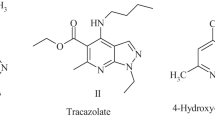Summary
The effects of homologue 4-hydroxy-enales, especially 4-hydroxy-pentenale (HPE), on subcutaneously implanted Ehrlich-ascites-tumor-cells (EATC) in vivo, and the persistence of HPE in the subcutaneous tissue have been investigated.
After “incubation” of EATC in subcutaneous depots of HPE, all of the tested hydroxy-enales caused death of about 90% of the EATC, as indicated by positive reaction with trypan-blue. Hydroxy-hexenale turned out to be less effective. However, no distinct influence of the length of the hydrocarbon-chain upon the effectiveness of the aldehydes was observed.
HPE injected simultaneously with EATC into subcutaneous tissue showed, depending on the given dose, an optimal inhibitory effect at about 3·10−7 m/g body weight. Three weeks after implantation, 50% of the animals remained tumor-free, 48% showed predominantly strong inhibition of the tumor-growth, and 2% showed no significant inhibition. The average inhibition of tumor-growth was 91%.
Twelve weeks after the same treatment 50% of the treated animals also remained tumor-free.
Measurements of the persistence of HPE in the subcutaneous tissue showed, depending on the injected dose, an optimum of about 2.5–3.5·10−7m/g body weight.
The half-life of the free HPE in the subcutaneous tissue came to 2–3 minutes.
Zusammenfassung
Es wurden die Wirkung von vier homologen Hydroxy-enalen, insbesondere von Hydroxy-pentenal, auf subcutan implantierte Ehrlich-Ascites-Tumorzellen in vivo sowie die Persistenz von Hydroxy-pentenal in subcutanen Depots untersucht.
Dabei ergab sich:
Alle untersuchten Hydroxy-enale führten bei “Inkubation” von EATZ in Subcutandepots und anschließender Färbung mit Trypanblau zu etwa 90% trypanpositiven, also sicher devitalisierten Zellen. Ein gesetzmäßiger Gang der Abhängigkeit der Wirkung von der Kettenlänge der Aldehyde konnte nicht nachgewiesen werden.
Die Simultanversuche ergaben abhängig von der gegebenen Dosis ein Wirkungsoptimum von HPE bei 3·10−7m/g KG nach 3 Wochen, wobei bei 50% der behandelten Versuchstiere das Tumorwachstum verhindert, bei 48% verzögert und bei 2% ungehemmt war. Die mittlere Hemmung des Tumorwachstums betrug 91%.
Der zwölfwöchige Simultanversuch bestätigte die oben genannten Ergebnisse: 10 von 20 Versuchstieren überlebten die Beobachtungszeit tumorfrei.
Persistenzmessungen an HPE in subcutanen Depots ergaben ein Maximum der Verweilzeit des Aldehyds im Bereich von 2,5–3,5·10−7m/g KG. Die Halbwertszeit für das freie HPE im subcutanen Gewebe beträgt 2–3 min.
Similar content being viewed by others
Literatur
Ardenne, M. v.: Theoretische und experimentelle Grundlagen der Krebs-Mehrschritt-Therapie, S. 307 ff. Berlin: VEB Verlag Volk und Gesundheit 1967.
Bickis, I. J., and E. Schauenstein: The effects of hydroxy-pentenale on tumor cell metabolism in vitro. 5th Intern. Congr. Chemotherapy, Abstracts, B 9/7 (1967).
Burk, D., and M. Woods: Hyperthermy-chemotherapy of mouse melanoma and Ehrlich ascites cancer cells. 5th Intern. Congr. Chemotherapy, Abstracts A IV-1b/13 (1967).
Dorner, F.: Diss. Univ. Graz (1967).
Esterbauer, H., u. W. Weger: Über die Wirkung von Aldehyden auf gesunde und maligne Zellen. 2. Mitt: Synthese von homologen 4-Hydroxy-2,3-alkenalen, I, bzw. 3. Mitt.: Synthese von homologen 4-hydroxy-2,3-alkenalen, II. Mh. Chem. (1967) (im Druck).
Ratzenhofer, M., u. J. Zangger: Stalagmose und Stalagmoptyse, ein, charakteristischer zytopathologischer Effekt an Ehrlich-Ascites-Tumorzellen. Beitr. path. Anat. 130, 243 (1964).
—: Cytotoxische Effekte an Krebszellen. Verh. Dtsch. Ges. Pathol., 48. Tagg, 119 (1964).
Schauenstein, E.: Autoxydation of polyunsaturated-esters in water: chemical structure and biological activity of the products. J. Lipid Res. 8, 417 (1967).
— H. Esterbauer, G. Jaag u. M. Taufer: Über die Wirkungen von Aldehyden auf gesunde und maligne Zellen. 1. Mitt.: Hydroxy-octenal, ein neuer Fettaldehyd. Mh. Chem. 95, 180 (1964).
—, J. Zangger u. M. Rathenhofer: Über die Wirkung von Hydroxy-octenal auf Ehrlich-Ascites-Tumorzellen. Z. Naturforsch 19b, 923 (1964).
Seeger, P. G., u. W. Schacht: Untersuchungen am Ehrlichschen Ascitescarcinom der Maus: Die Trypanblaufärbung von Tumorzellen als Kriterium der Mortalität. Protoplasma 50 (1), 1 (1959).
Sexton, W. A.: Chemische Konstitution und biologische Wirkung, S. 59. Weinheim: Verlag Chemie 1958.
Author information
Authors and Affiliations
Additional information
Die Untersuchungen wurden mit Unterstützung des Österreichischen Forschungsrates Wien durchgeführt.
Rights and permissions
About this article
Cite this article
Schauenstein, E., Wünschmann, B. & Esterbauer, H. Über die weitgehend selektive Abtötung subcutan implantierter Ehrlich-Ascites-Tumorzellen in vivo durch 4-Hydroxy-enale, insbesondere 4-Hydroxy-pentenal. Z Krebs-forsch 71, 21–29 (1968). https://doi.org/10.1007/BF00524498
Received:
Issue Date:
DOI: https://doi.org/10.1007/BF00524498




